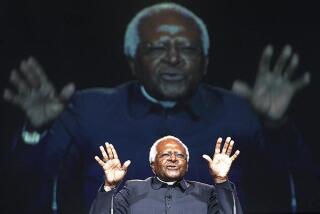A Tut Whodunit
- Share via
An overwhelming lust for power, a romantic triangle and a serial killer are the key ingredients in a 3,300-year-old King Tut murder mystery, whose details are just now becoming clear, an archeologist said Friday in Pasadena.
The central figure in the sordid story is Tutankhamen, the boy king whose buried treasures made him one of the most famous of ancient Egypt’s rulers despite the fact that he died at age 20.
The villain of the piece is Aye (pronounced “I”), the commoner who ruled Egypt as regent while Tutankhamen grew up, said Egyptologist Bob Brier of Long Island University.
Aye or one of his henchmen probably killed Tutankhamen by breaking his skull with a blow to the back of the head, Brier said. The lustful regent then killed a suitor from the neighboring kingdom of the Hittites who was summoned by Tut’s widow, married the widow himself to become pharaoh and then killed her as well.
*
“It’s the old story of power, jealousy and greed,” Brier said. “The evidence that we have would probably not convict Aye in a modern court of law, but I think it is the best theory of what happened.”
Others are not so sure, however. “It’s a fairly imaginative theory,” said Emily Teeter, assistant curator of the Oriental Institute Museum at the University of Chicago. “It could be true . . . but it’s completely unprovable. It’s no truer than any of the other [less dramatic] scenarios.”
“It’s speculation,” said Dorothea Arnold, a curator at the Metropolitan Museum in New York City. “The man died very young . . . but we have no other evidence in any literary source that points to this theory in any way.”
In contrast, Rita Freed, curator of the Egyptian and Nubian department at the Boston Museum of Fine Arts, conceded that Brier’s ideas are “speculative,” but noted that “it is absolutely possible that this was orchestrated by Aye. We have to have a theory out there to work with, and this is an interesting one. From that, we’ll come closer to the truth, whatever it is.”
Tutankhamen was only 10 when his father, Akhenaten, died. Aye, Akhenaten’s advisor, served as regent while Tut was growing up, effectively running the country. Tut, meanwhile, married his half-sister Ankhesenamen.
Brier bases his scenario on several pieces of evidence. Many individual facts have been known for some time, but Brier may be the first to combine them in this fashion.
One undisputed fact is that Tut died at age 20 in 1350 BC. Last summer, Brier and Dr. Gerald Irwin, a radiologist at Long Island University, examined an X-ray of Tut’s skull. Based on the presence of a bone sliver, they concluded that he had died from a blow to the back of the head.
The X-ray also revealed what appeared to a clot at the site, suggesting that Tut had lived for at least a while after the blow, perhaps lingering in unconsciousness.
Ankhesenamen then wrote to the king of the neighboring Hittites, begging him to send one of his sons to be her husband--an unheard-of request from an Egyptian queen.
*
The letter, a cuneiform tablet now in a museum in Turkey, says, “Never shall I pick out a servant of mine and make him my husband! I am very afraid,” suggesting that she was being coerced into a marriage.
The Hittite king acquiesced and sent a son, but the prince was killed near the Egyptian border.
Meanwhile, Aye quickly succeeded Tut. A mural on the wall of Tut’s tomb, painted shortly after Tut’s death, shows Aye wearing the pharaoh’s crown. But Aye was a commoner and could not become pharaoh without marrying into the royal family.
Apparently he did. In 1931, archeologist Percy Newberry discovered a ring in a Cairo antiquities shop bearing an inscription indicating that Aye and Ankhesenamen were married. That ring is now in the Egyptian Museum in Berlin.
Ankhesenamen was never heard from again. When Aye died and was buried three years later, the walls of his tomb showed another woman, Tiy, as his wife and the queen of Egypt. Brier believes that Aye killed Ankhesenamen to consolidate his power and enable him to marry Tiy. “That makes him a serial killer,” Brier said.
Brier gathered the information while researching a forthcoming television program, “The Mystery of Tutankhamen,” which will be shown on the Learning Channel on April 6. “By the time we were done, we all really hated Aye,” he said Friday at a preview of the series.
“Aye was an ambitious and boastful man,” Brier said.
On his tomb wall at Amarna, Aye brags, “I was one favored by his lord every day, great in favor from year to year, because of the exceeding greatness of my excellence.”
“It’s easy to imagine that such a man could kill,” Brier concluded.
*
But others find holes in the theory. James Harris of the University of Michigan, a dentist who specializes in the forensics of mummies, has X-rayed the skull of Tutankhamen, although he did not show the films to Brier. He confirms that there is a bone sliver, but notes that it could have been produced during the mummification process or in an accident before death.
“Our work does not indicate what he died from,” Harris said. “I certainly don’t know what the cause of Tutankhamen’s death was, and I don’t know anybody else who does.”
“It would be wonderful if we could prove this,” Teeter said. “There are so many resonances which appeal to us with a sense of drama and literature. . . . But we simply have no way of tying things together in a way that is convincing.”
Nonetheless, she concedes, there is certainly value in trying to put all the pieces together. “Even if they might ultimately all be in the wrong places, we have to get them together to see what the errors might be.”
More to Read
The biggest entertainment stories
Get our big stories about Hollywood, film, television, music, arts, culture and more right in your inbox as soon as they publish.
You may occasionally receive promotional content from the Los Angeles Times.










